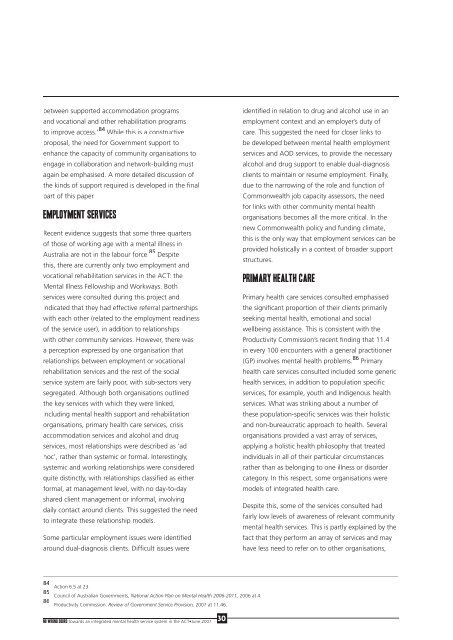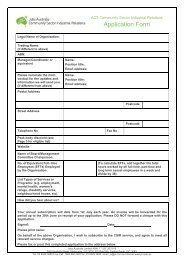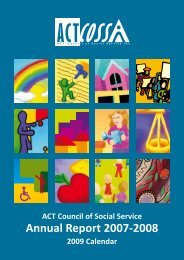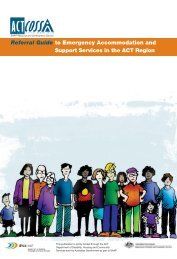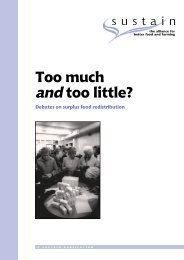actcoss text final.indd - ACT Council of Social Service
actcoss text final.indd - ACT Council of Social Service
actcoss text final.indd - ACT Council of Social Service
Create successful ePaper yourself
Turn your PDF publications into a flip-book with our unique Google optimized e-Paper software.
etween supported accommodation programs<br />
and vocational and other rehabilitation programs<br />
to improve access.’ 84 While this is a constructive<br />
proposal, the need for Government support to<br />
enhance the capacity <strong>of</strong> community organisations to<br />
engage in collaboration and network-building must<br />
again be emphasised. A more detailed discussion <strong>of</strong><br />
the kinds <strong>of</strong> support required is developed in the <strong>final</strong><br />
part <strong>of</strong> this paper.<br />
EMPLOYMENT SERVICES<br />
Recent evidence suggests that some three quarters<br />
<strong>of</strong> those <strong>of</strong> working age with a mental illness in<br />
Australia are not in the labour force. 85 Despite<br />
this, there are currently only two employment and<br />
vocational rehabilitation services in the <strong>ACT</strong>: the<br />
Mental Illness Fellowship and Workways. Both<br />
services were consulted during this project and<br />
indicated that they had effective referral partnerships<br />
with each other (related to the employment readiness<br />
<strong>of</strong> the service user), in addition to relationships<br />
with other community services. However, there was<br />
a perception expressed by one organisation that<br />
relationships between employment or vocational<br />
rehabilitation services and the rest <strong>of</strong> the social<br />
service system are fairly poor, with sub-sectors very<br />
segregated. Although both organisations outlined<br />
the key services with which they were linked,<br />
including mental health support and rehabilitation<br />
organisations, primary health care services, crisis<br />
accommodation services and alcohol and drug<br />
services, most relationships were described as ‘ad<br />
hoc’, rather than systemic or formal. Interestingly,<br />
systemic and working relationships were considered<br />
quite distinctly, with relationships classified as either<br />
formal, at management level, with no day-to-day<br />
shared client management or informal, involving<br />
daily contact around clients. This suggested the need<br />
to integrate these relationship models.<br />
Some particular employment issues were identified<br />
around dual-diagnosis clients. Difficult issues were<br />
identified in relation to drug and alcohol use in an<br />
employment con<strong>text</strong> and an employer’s duty <strong>of</strong><br />
care. This suggested the need for closer links to<br />
be developed between mental health employment<br />
services and AOD services, to provide the necessary<br />
alcohol and drug support to enable dual-diagnosis<br />
clients to maintain or resume employment. Finally,<br />
due to the narrowing <strong>of</strong> the role and function <strong>of</strong><br />
Commonwealth job capacity assessors, the need<br />
for links with other community mental health<br />
organisations becomes all the more critical. In the<br />
new Commonwealth policy and funding climate,<br />
this is the only way that employment services can be<br />
provided holistically in a con<strong>text</strong> <strong>of</strong> broader support<br />
structures.<br />
PRIMARY HEALTH CARE<br />
Primary health care services consulted emphasised<br />
the significant proportion <strong>of</strong> their clients primarily<br />
seeking mental health, emotional and social<br />
wellbeing assistance. This is consistent with the<br />
Productivity Commission’s recent finding that 11.4<br />
in every 100 encounters with a general practitioner<br />
(GP) involves mental health problems. 86 Primary<br />
health care services consulted included some generic<br />
health services, in addition to population specific<br />
services, for example, youth and Indigenous health<br />
services. What was striking about a number <strong>of</strong><br />
these population-specific services was their holistic<br />
and non-bureaucratic approach to health. Several<br />
organisations provided a vast array <strong>of</strong> services,<br />
applying a holistic health philosophy that treated<br />
individuals in all <strong>of</strong> their particular circumstances<br />
rather than as belonging to one illness or disorder<br />
category. In this respect, some organisations were<br />
models <strong>of</strong> integrated health care.<br />
Despite this, some <strong>of</strong> the services consulted had<br />
fairly low levels <strong>of</strong> awareness <strong>of</strong> relevant community<br />
mental health services. This is partly explained by the<br />
fact that they perform an array <strong>of</strong> services and may<br />
have less need to refer on to other organisations,<br />
___________________________________________________________________________________________________________________________<br />
84 Action 6.5 at 23.<br />
85 <strong>Council</strong> <strong>of</strong> Australian Governments, National Action Plan on Mental Health 2006-2011, 2006 at 4.<br />
86 Productivity Commission. Review <strong>of</strong> Government <strong>Service</strong> Provision, 2007 at 11.46.<br />
NO WRONG DOORS Towards an integrated mental health service system in the <strong>ACT</strong>•June 2007<br />
30


